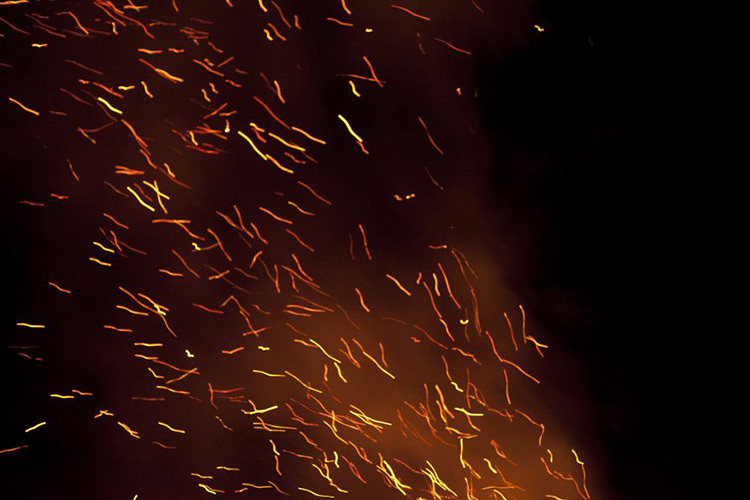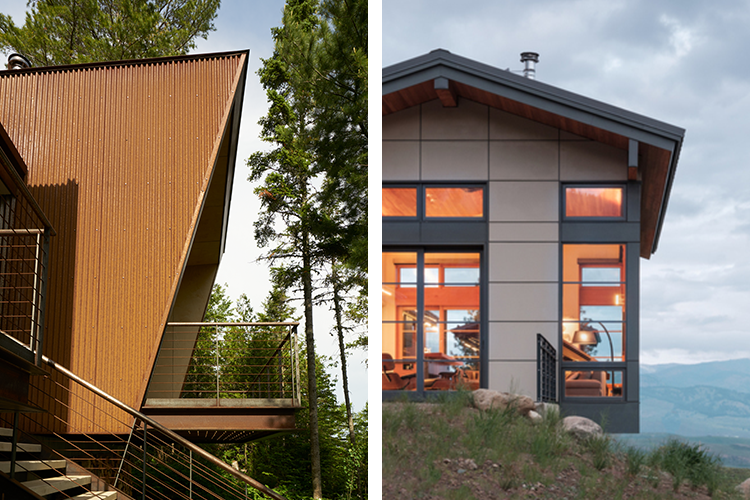"FIREWISE" OR "HOME HARDENING"
"FIREWISE" OR "HOME HARDENING"
After the devastating fires in the Los Angeles area, we decided to put together this post to talk about our experience with "Firewise" design. It is home and site features designed to reduce wildfire risk and damage to a home, an increasing concern in the Pacific Northwest and all along the West coast. We'll cover what causes a house fire, the strategies we use to prevent it, and a recent case study from one of our homes.
WHAT CAUSES A HOUSE TO BURN?
In wildfires, firebrands (burning embers carried by wind) ignite more homes than direct flame contact. These embers can travel miles ahead of a fire, landing on roofs, in gutters, or near vulnerable structures, where they smolder and ignite combustible materials. The first step in Firewise homes is always to reduce the risk of direct fire contact, but firebrands are typically the deadliest threat. Below are the basic strategies we employ to minimize this risk.

DEFENSIBLE SPACE
"Defensible space" is a buffer between a home and potential wildfire fuels. By maintaining a low-combustible landscape — such as gravel, trimmed vegetation, and fire-resistant plants — homeowners can slow the spread of fire and reduce ember ignition risks. This is the most effective strategy to reduce the risk of a house fire. This space is typically divided into three "zones." The "immediate" zone (0-5 feet) ideally has no combustible material. The "intermediate" zone (5-30 feet) has mostly low plantings, properly spaced trees and no "ladder fuels" (vegetation under trees). Finally the "extended" zone (30-100 feet) should provide interruptions to the fire path and try to minimize flame size.

Left: National Fire Protection Association Home Ignition Zone Diagram Right: A concrete walk and steel planter creates a low-combustible space around the Aspen Grove Residence.
BUILDING EXTERIOR
Building with materials resistant to ignition is key to a Firewise design. Non-combustible roofs are a must. We typically choose standing seam metal roofs for their longevity and crisp profile. Non-combustible siding is next, with metal or fiber cement panels being popular. If wood siding is desired, fire resistant gypsum panels or rockwool exterior insulation can be installed behind the siding to stop fire spread. Concrete patios are preferred over wood decks where possible to reduce combustible materials near the home.

MINIMIZE BUILDING VENTS
Vents can allow embers to enter attics and crawl spaces, igniting a home from within. Using ember-resistant vent covers or eliminating unnecessary vents reduces this risk while maintaining proper ventilation. Through proper insulation and mechanical venting, we typically eliminate vents to roof cavities and crawlspaces.
CASE STUDY: LITTLE WOLF RESIDENCE
The Little Wolf residence employs a full suite of Firewise strategies. What makes it unique is that it showcases how sustainable strategies can work together with Firewise methods to create a safe, environmentally sensitive home.
This house and site design features all of the standard elements of smart Firewise design — metal roof, fiber cement siding, unvented roof and crawl space, and well-maintained landscape with defensible space.
In addition, the home has a full suite of sustainable features including a full solar array with back up batteries, all electric appliances, geothermal heating, and an HRV (Heat Recovery Ventilation) system.
All these strategies were put to the test 2021 when the Cedar Creek Fire raged through the valley, coming perilously close to the house. All the exterior strategies kept the home resistant to fire embers while the defensible space kept the fire at bay. It was further preserved by the HRV system which minimized smoke damage to the interiors, and solar panels kept the house running during the power outage caused by the fire.

Our firm is committed to incorporating Firewise design principles when applicable, ensuring our clients' homes are both safe and resilient. We carefully integrate these strategies without compromising aesthetics, blending fire resistance with thoughtful design to create beautiful spaces. Please reach out with any questions about how we can help you design a Firewise home.
Want to learn more? Here are some additional resources:
Washington Department of Natural Resources
https://www.dnr.wa.gov/firewise
Fire Adapted - Methow Valley foundation to promote Firewise Practices
https://www.fireadaptedmethow.org/resources
Idaho Firewise - Resource for selecting fire resistant plants
https://idahofirewise.org/firewise-landscapes/firewise-plant-materials/
Bring Your Own Brigade - Documentary on the 2018 wildfires that provides a character-driven investigation into the cause of - and solutions to - the global wildfire epidemic
https://www.bringyourownbrigade.com/
